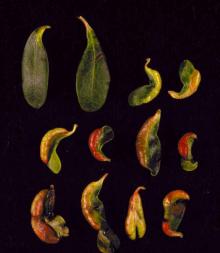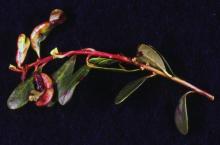See:
Azalea (Rhododendron spp.) - Leaf and Flower Gall
Cause Large white to brown leaf and flower galls are caused by Exobasidium spp. Several species have been reported from the Pacific Northwest including E. vaccinii, which is common on azalea as well as other Arctostaphylos spp., E. arctostaphyli, E. uva-ursi and E. vaccinii-uliginosi. It is not clear if isolates from azalea can infect kinnikinnick or vice versa. An aphid (Manzanita leafgall aphid) causes smaller, red leaf galls. See the PNW Insect Management Handbook for more information.
Symptoms Initially, infected plant parts show a thickening and then gradually become fleshy in appearance. Infected leaves and flowers thicken into greenish to pinkish galls. As the galls mature, they become covered with a dense white coating of fungal spores. Galls finally become brown and woody. Healthy plants can easily tolerate considerable amounts of galling without serious damage.
Cultural control
- Avoid overhead watering or limit it to times when the foliage can dry quickly.
- Pick and destroy thickened, fleshy leaves and flowers before the white fungal spores appear.
- Remove these old galls from plants before bloom and flushes of new growth.
- Space plants and prune to reduce humidity.
- The cultivar Massachusetts is reported resistant to leaf gall.
Reference Farr, D.F., Bills, G.F., Chamuris, G.P., and Rossman, A.Y. 1989. Fungi on plants and plant products in the United States. APS press.



